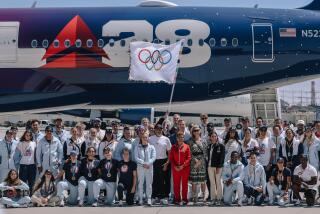Lesson to Be Learned in Traffic Management, Study Says : Use of Olympics Ideas Urged to Ease Freeway Congestion
An all-out push to control congestion during the 1984 Olympic Games reduced the number of cars on the freeways by nearly 3%--a feat that probably cannot be duplicated under normal conditions but can serve as a guide for easing rush-hour traffic, a new study concludes.
The Orange County Transportation Commission, in a report scheduled for discussion on Monday, found that transportation officials can capitalize on many of the traffic management techniques inaugurated during the Olympics, including flexible working hours for employees, greater use of car pools and van pools and higher transit ridership, to help reduce freeway congestion.
“The success of Southern California’s transportation system during the 1984 Olympic Games was unprecedented. The free-flowing traffic was a sharp contrast to the expected massive gridlock on the highway system. The coordinated efforts of the public and private sectors facilitated implementation of many (traffic management) techniques that proved instrumental in reducing traffic problems,” said the report, commissioned at the request of county Supervisor Harriett Wieder.
“Although the success was short-lived, there are some lessons to be learned from the Olympic traffic success. It was a demonstration that transportation systems management can significantly reduce congestion on our roads,” the report said, noting that a number of such techniques are already being use or are under study in Orange County.
Among them:
- Shifting trips to and from work to off-peak hours. Allowing employees to come to work either earlier or later than usual, or scheduling four-day work weeks, helped reduce rush-hour traffic. The Orange County Transit District is conducting a “flex-time” study to determine how more flexible working hours can reduce freeway congestion.
Transportation officials found that 97% of the companies they surveyed offered staggered work hours during the Olympics, compared to 19% before the Games.
ITT Cannon temporarily shut down plants in Santa Ana and Fountain Valley, removing 2,800 commuters from the road, an option which is not available year-round.
- Encouraging car-pooling and van-pooling. County officials have calculated that even a small increase in ridesharing--for example, increasing car occupancy from 1.2 to 1.3 riders--could eliminate most stop-and-go traffic during rush hours. The study found that despite extensive marketing of the car-pooling approach during the Olympics, the level of ridesharing increased very little during the Games.
The study added: “Where possible, employers should minimize work-related travel. Besides supporting shared transportation, companies can promote fewer field trips, plan meeting schedules that do not contribute to peak hour traffic, reduce shipping and deliveries and provide shuttle services where appropriate.”
- Promoting bus travel. The Los Angeles Games were the first events since the Olympics at Melbourne in 1956 not to have a rail system for transit use, but ridership on Orange County Transit District buses was up 12% during the Olympics, in part because of extensive information distributed about bus service and free rides to event sites from park-and-ride facilities.
“The Olympic experience proved that when motivated to do so, the public will park their vehicles and ride buses to their destinations,” the study suggested.
The report recommended three courses of action for the Transportation Commission to help implement its suggestions: provide the public with information on Olympics-style traffic management, support OCTD’s employer “flex-time” studies and continue to promote “alternative solutions improving the traffic situation.”
More to Read
Sign up for Essential California
The most important California stories and recommendations in your inbox every morning.
You may occasionally receive promotional content from the Los Angeles Times.









